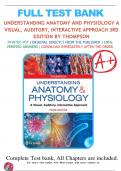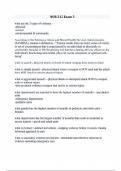FULL TEST BANK
UNDERSTANDING ANATOMY AND PHYSIOLOGY A
VISUAL, AUDITORY, INTERACTIVE APPROACH 3RD
EDITION BY THOMPSON
PRINTED PDF | ORIGINAL DIRECTLY FROM THE PUBLISHER | 100%
VERIFIED ANSWERS | DOWNLOAD IMMEDIATELY AFTER THE ORDER
Complete Test bank, All Chapters are included.
For more Test banks, ATI, HESI exams, and more contact us.
, Stuvia.com Stuvia.com - The
T he MarketplaceMarketplace to
to BuyB uy
and
andSellSell youryour StudyS tudy MaterialMaterial
Table of Contents
Chapter 1: Orientation to the Human Body 1
Chapter 2: Chemistry of Life 9
Chapter 3: Cells 23
Chapter 4: Human Microbiome 32
Chapter 5: Tissues 40
Chapter 6: Integumentary System 53
Chapter 7: Bones & Bone Tissue 63
Chapter 8: Skeletal System 71
Chapter 9: Joints 83
Chapter 10: Muscular System 90
Chapter 11: Nervous System 99
Chapter 12: Sense Organs 116
Chapter 13: Endocrine System 124
Chapter 14: Blood 134
Chapter 15: Heart 143
Chapter 16: Vascular System 158
Chapter 17: Lymphatic & Immune Systems 177
Chapter 18: Respiratory System 188
Chapter 19: Urinary System 198
Chapter 20: Fluid, Electrolyte & Acid-Base Balance 206
Chapter 21: Digestive System 214
Chapter 22: Nutrition & Metabolism 224
Chapter 23: Reproductive Systems 235
Chapter 24: Pregnancy & Human Development 243
Chapter 25: Heredity 251
Downloaded by: Quizmatics | paulwilson55497@yahoo.com Want to earn $1.236
Distribution of this document is illegal extra per year?
,Chapter 1: Orientation To The Human Body
Match The Name Of Each Organ System To Its Key Components.
A. Integumentary System
B. Skeletal System
C. Muscular System
D. Lymphatic System
E. Respiratory System
F. Urinary System
G. Nervous System
H. Endocrine System
I. Circulatory System
J. Digestive System
K. Male Reproductive System
L. Female Reproductive System
1. Consists Of Stomach, Small And Large Intestines, Liver, And Pancreas
2. Consists Of Skin, Hair, And Nails
3. Consists Of Kidneys, Ureters, Urinary Bladder, And Urethra
4. Consists Primarily Of Skeletal Muscles
5. Consists Of Heart, Arteries, Veins, And Capillaries
6. Consists Of Brain, Spinal Cord, Nerves, And Sense Organs
7. Consists Of Ovaries, Fallopian Tubes, Uterus, Vagina, And Breasts
8. Consists Of Pituitary Gland, Adrenals, Pancreas, And Thyroid
9. Consists Of Lymph Nodes, Lymphatic Vessels, Lymph, Thymus, And Spleen
10. Consists Of The Nose, Pharynx, Larynx, Trachea, Bronchi, And Lungs
Match Each Term To Its Definition.
A. Distal
B. Proximal
C. Medial
D. Lateral
E. Superior
F. Inferior
G. Anterior
H. Posterior
I. Superficial
J. Deep
11. Toward The Back Of The Body
12. Farthest From The Point Of Origin
13. Above
14. At Or Near The Body’s Surface
15. Toward The Body’s Midline
16. Closest To The Point Of Origin
17. Toward The Front Of The Body
,18. Below
Match Each Term To Its Location On The Body.
A. Frontal
B. Deltoid
C. Brachial
D. Inguinal
E. Pectoral
F. Sternal
G. Digital
H. Antecubital
I. Buccal
J. Cephalic
K. Lumbar
L. Calcaneal
M. Plantar
N. Pedal
O. Tarsal
P. Axillary
19. Arm
20. Lower Back
21. Armpit
22. Heel
23. Fingers
24. Shoulder
, 25. Sole Of The Foot
26. Forehead
27. Chest
28. Front Of Elbow
29. Foot
30. Cheek
31. Groin
32. Ankle
Multiple Choice
Identify The Choice That Best Completes The Statement Or Answers The Question.
33. Which Organ System Produces Immune Cells And Has A Role In Fluid Balance?
A. Integumentary System
B. Circulatory System
C. Endocrine System
D. Lymphatic System
34. Which Organ System Protects Organs, Allows For Support And Movement, And Also Plays A Key Role
In BloodFormation?
A. Circulatory System
B. Muscular System
C. Skeletal System
D. Nervous System
35. Which Type Of Tissue Covers The Body’s Surface?
A. Epithelial
B. Connective
C. Muscle
D. Nerve
36. Bone, Cartilage, And Adipose Tissue Are All Types Of
A. Epithelial Tissue.
B. Connective Tissue.
C. Muscle.
D. Nerve Tissue.
37. The Type Of Plane That Divides The Body Horizontally Into Upper And Lower Portions Is Called A
A. Sagittal Plane.
B. Frontal Plane.
C. Transverse Plane.
D. Coronal Plane.
38. Most Illustrations That Show The Contents Of The Abdominal Cavity Use What Type Of Plane?
A. Sagittal
B. Transverse
C. Horizontal
, D. Frontal
39. Which Of The Following Correctly Describes The Anatomical Position?
A. Standing Erect, Facing Forward, With Arms Outstretched
B. Standing Erect With Arms At Sides, Palms Facing Backward, Face And Feet Facing
Forward
C. Standing Erect With Arms Overhead, Face And Feet Facing Forward
D. Standing Erect With Arms At Sides And With Palms, Face, And Feet Facing Forward
40. The Dorsal Cavity Contains The
A. Thoracic And Abdominopelvic
Cavities.
B. Cranial And Spinal Cavities.
C. Mediastinum And Pleural Cavities.
D. Abdominal And Pelvic Cavities.
41. The Heart Is Located In The Mediastinum, Which Is Part Of What Cavity?
A. Thoracic Cavity
B. Dorsal Cavity
C. Spinal Cavity
D. Cranial Cavity
42. A Patient Comes To The Hospital For Treatment Of Pain In The Right Hypochondriac Region. Based On
The OrgansLocated In That Region, Which Organ Might Be Causing The Pain?
A. Stomach
B. Small Intestines
C. Gallbladder
D. Appendix
Completion
Complete Each Statement.
43. The Structure Of The Body Is Called ; How It Functions Is Called .
44. The Human Body Is Organized From The Very To The Very .
45. The Region Proximal To The Patellar Region And Distal To The Inguinal Region Is The
Region.
46. The Region Superior To The Pubic Region And Inferior To The Abdominal Region Is The
Region.
47. The Two Major Body Cavities Are The And Cavities.
48. The Constancy Of The Body’s Internal Environment Is Called .
49. Feedback Is When An Effector Opposes The Stimulus And Reverses The
Direction OfChange.
50. During Childbirth, The Hormone Oxytocin Is Released, Which Causes Even Greater Contractions And An
Even GreaterRelease Of Oxytocin. This Is An Example Of Feedback.
,Chapter 1: Orientation To The Human
BodyAnswer Section
MATCHING
1. ANS: J PTS: 1 DIF: E REF: 6
KEY: REMEMBERING
2. ANS: A PTS: 1 DIF: E REF: 5
KEY: REMEMBERING
3. ANS: F PTS: 1 DIF: E REF: 5
KEY: REMEMBERING
4. ANS: C PTS: 1 DIF: E REF: 5
KEY: REMEMBERING
5. ANS: I PTS: 1 DIF: E REF: 6
KEY: REMEMBERING
6. ANS: G PTS: 1 DIF: E REF: 6
KEY: REMEMBERING
7. ANS: L PTS: 1 DIF: E REF: 6
KEY: REMEMBERING
8. ANS: H PTS: 1 DIF: E REF: 6
KEY: REMEMBERING
9. ANS: D PTS: 1 DIF: E REF: 5
KEY: REMEMBERING
10. ANS: E PTS: 1 DIF: E REF: 5
KEY: REMEMBERING
11. ANS: H PTS: 1 DIF: E REF: 7
KEY: REMEMBERING
12. ANS: A PTS: 1 DIF: E REF: 7
KEY: REMEMBERING
13. ANS: E PTS: 1 DIF: E REF: 7
KEY: REMEMBERING
14. ANS: I PTS: 1 DIF: E REF: 7
KEY: REMEMBERING
15. ANS: C PTS: 1 DIF: E REF: 7
KEY: REMEMBERING
16. ANS: B PTS: 1 DIF: E REF: 7
KEY: REMEMBERING
17. ANS: G PTS: 1 DIF: E REF: 7
KEY: REMEMBERING
18. ANS: F PTS: 1 DIF: E REF: 7
KEY: REMEMBERING
19. ANS: C PTS: 1 DIF: M REF: 9
KEY: REMEMBERING
20. ANS: K PTS: 1 DIF: M REF: 9
KEY: REMEMBERING
, 21. ANS: P PTS: 1 DIF: M REF: 9
KEY: REMEMBERING
22. ANS: L PTS: 1 DIF: M REF: 9
KEY: REMEMBERING
23. ANS: G PTS: 1 DIF: M REF: 9
KEY: REMEMBERING
24. ANS: B PTS: 1 DIF: M REF: 9
KEY: REMEMBERING
25. ANS: M PTS: 1 DIF: M REF: 9
KEY: REMEMBERING
26. ANS: A PTS: 1 DIF: M REF: 9
KEY: REMEMBERING
27. ANS: E PTS: 1 DIF: M REF: 9
KEY: REMEMBERING
28. ANS: H PTS: 1 DIF: M REF: 9
KEY: REMEMBERING
29. ANS: N PTS: 1 DIF: M REF: 9
KEY: REMEMBERING
30. ANS: I PTS: 1 DIF: M REF: 9
KEY: REMEMBERING
31. ANS: D PTS: 1 DIF: M REF: 9
KEY: REMEMBERING
32. ANS: O PTS: 1 DIF: M REF: 9
KEY: REMEMBERING
MULTIPLE CHOICE
33. ANS: D
The Lymphatic System Produces Immune Cells And Has A Role In Fluid Balance. The Integumentary
System Has ARole In Protection, Temperature Regulation, Water Retention, And Sensation. The Circulatory
System Distributes Oxygen, Nutrients, Water, Hormones, And Other Electrolytes; It Also Has A Role In
Fluid And Electrolyte Balance. The Endocrine System Produces Hormones And Regulates Other Systems.
PTS: 1 DIF: E REF: 5 KEY: REMEMBERING
34. ANS: C
The Skeletal System Protects Organs, Gives The Body Support And Allows It To Move, And Also Plays A
Role In TheFormation Of Blood Cells. The Circulatory System Distributes Oxygen, Nutrients, Water,
Hormones, And Other Electrolytes; It Also Has A Role In Fluid And Electrolyte Balance. The Muscular
System Allows The Body To MoveAnd Produces Heat. The Nervous System Regulates And Coordinates
Other Systems, And Also Has A Role In Sensation And Memory.
PTS: 1 DIF: E REF: 5 KEY: REMEMBERING
35. ANS: A
Epithelial Tissue Covers The Body Surfaces. Connective Tissue Connects And Supports Parts Of The Body.
MuscleContracts To Produce Movement. Nerve Tissue Generates And Transmits Impulses To Regulate Body
Function.
PTS: 1 DIF: E REF: 4 KEY: REMEMBERING
36. ANS: B
Bone, Cartilage, And Adipose Tissue Are All Types Of Connective Tissue.





